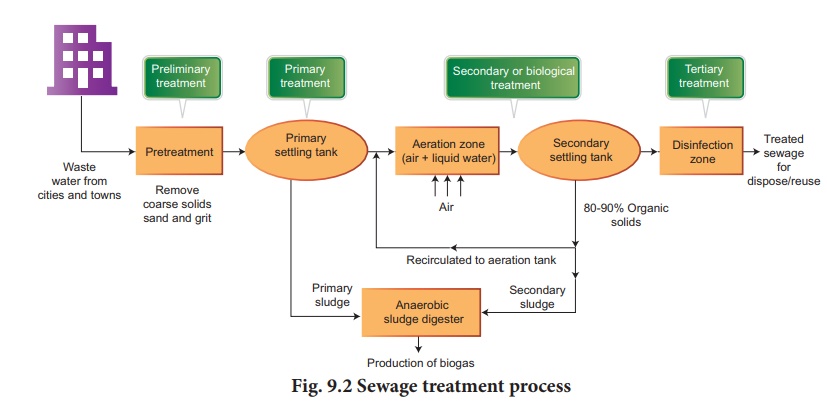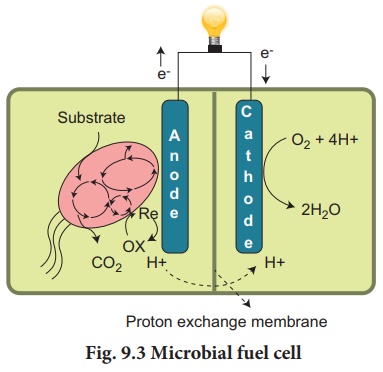Microbes in Human Welfare - Microbes in sewage treatment and energy generation | 12th Zoology : Chapter 9 : Microbes in Human Welfare
Chapter: 12th Zoology : Chapter 9 : Microbes in Human Welfare
Microbes in sewage treatment and energy generation

Microbes in sewage
treatment and energy generation
Sewage is the waste generated every day in
cities and towns containing human excreta. It contains large amounts of organic
matter and microbes, which are pathogenic to humans and are bio-degradable pollutants.
Domestic waste consists of approximately 99 percent water, suspended solids and
other soluble organic and inorganic substances. Sewage should not be discharged
directly into natural water bodies like rivers and streams. Before disposal,
sewage should be treated in sewage treatment plants to make it less polluting (Fig.
9.2).

1. Wastewater treatment
The main objective of a wastewater treatment
process is to reduce organic and inorganic components in wastewater to a level
that it no
Microorganisms mainly bacteria and
some protozoa play an essential part in the treatment of sewage to make it
harmless. Sewage contains pathogenic bacteria. These bacteria must be destroyed
in order to prevent the spread of diseases. Sewage treatment is usually
performed in the following three stages.
Primary treatment
Primary treatment involves the physical removal
of solid and particulate organic and inorganic materials from the sewage
through filtration and sedimentation. Floating debris is removed by sequential
filtration. Then the grit (soil and small pebbles) are removed by
sedimentation. All solids that settle form the primary sludge and the
supernatant forms the effluent. The effluent from the primary settling tank is
taken for secondary treatment.
Secondary treatment or biological treatment
The primary effluent is passed into large
aeration tanks where it is constantly agitated mechanically and air is pumped
into it. This allows vigorous growth of useful aerobic microbes into floc
(masses of bacteria associated with fungal filaments to form mesh like
structures). While growing, these microbes consume the major part of the
organic matter in the effluent. This significantly reduces the BOD (Biochemical
oxygen demand or Biological oxygen demand). BOD refers to the amount of the
oxygen that would be consumed, if all the organic matter in one litre of water
were oxidized by bacteria. The sewage water is treated till the BOD is reduced.
The greater the BOD of the waste water more is its polluting potential.
Once the BOD of sewage water is reduced
significantly, the effluent is then passed into a settling tank where the
bacterial “flocs” are allowed to sediment. This sediment is called activated
sludge. A small part of activated sludge is pumped back into the aeration
tank to serve as the inoculum. The remaining major part of the sludge is
pumped into large tanks called anaerobic sludge digesters. Here,
the bacteria which grow anaerobically, digest the bacteria and the fungi
in the sludge. During this digestion, bacteria produce a mixture of gases such
as methane, hydrogen sulphide and CO2. These gases form biogas and can be used as a
source of energy.
Tertiary treatment
Tertiary treatment is the final process that
improves the quality of the waste water before it is reused, recycled or
released into natural water bodies. This treatment removes the remaining
inorganic compounds and substances, such as nitrogen and phosphorus. UV is an
ideal disinfectant for wastewater since it does not alter the water quality –
except for inactivating microorganisms. UV is a chemical-free process that can
completely replace the existing chlorination system and also inactivates
chlorine-resistant microorganisms like Cryptosporidium and Giardia.
Act enforced by Government to conserve water bodies
National river conservation plan (NRCP) was
enacted in 1995 to improve the water quality of the rivers, which are the major
fresh water resources in our country. This important assignment taken up under
the NRCP includes,
·
To capture the raw sewage flowing into the river through open
drains and divert them for treatment.
·
Setting up sewage treatment plants for treating the diverted
sewage.
·
Construction of low cost sanitation toilets to prevent open
defecation on river banks.
The ministry for environment, forest and climate
change has initiated the Ganga action plan and the Yamuna action plan to save
the major rivers of the country.
The Ganga action plan was launched on 14th
January 1986. The main objective of the programme is to improve the water
quality of River Ganges by interception, diversion and treatment of domestic
sewage and to identify grossly polluting units to prevent pollution.
The Yamuna Action Plan is a bilateral project
between the Government of India and Japan. It was formally launched in April
1993. It was proposed to build large number of sewage treatment plants to
discharge treated wastewater into the rivers.
2. Microbial fuel cell(MFC)
A microbial fuel cell is a bio-electrochemical
system that drives an electric current by using bacteria and mimicking
bacterial interaction found in nature (Fig. 9.3). Microbial fuel cells
work by allowing bacteria to oxidize and reduce organic molecules. Bacterial
respiration is basically one big redox reaction in which electrons are being
moved around. A MFC consists of an anode and a cathode separated by a proton
exchange membrane. Microbes at the anode oxidize the organic fuel generating
protons which pass through the membrane to the cathode and the electrons pass
through the anode to the external circuit to generate current.

Related Topics